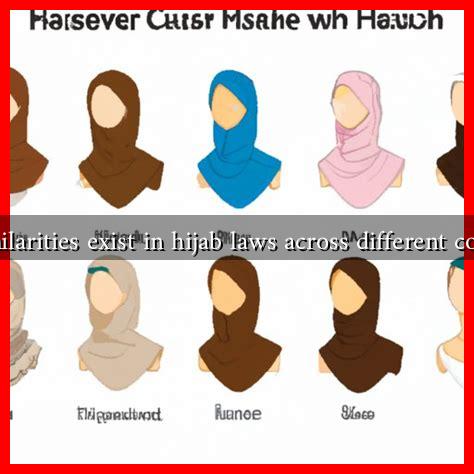-
Table of Contents
- What Similarities Exist in Hijab Laws Across Different Continents?
- Understanding Hijab Laws Globally
- Permissive Laws: Embracing Freedom of Choice
- Restrictive Laws: The Clash of Secularism and Religion
- Neutral Laws: A Balancing Act
- Case Studies: Real-World Implications
- Conclusion: The Global Landscape of Hijab Laws
What Similarities Exist in Hijab Laws Across Different Continents?
The hijab, a traditional headscarf worn by many Muslim women, has become a focal point of cultural, religious, and political discussions worldwide. While the hijab is often associated with Islamic identity, the laws governing its use vary significantly across different continents. However, despite these differences, certain similarities can be observed in hijab laws and regulations. This article explores these similarities, providing insights into how various regions approach the hijab and the implications for women’s rights and religious freedom.
Understanding Hijab Laws Globally
Hijab laws can be broadly categorized into three types: permissive, restrictive, and neutral. Each continent exhibits unique characteristics in how these laws are implemented, yet some commonalities emerge.
Permissive Laws: Embracing Freedom of Choice
In many countries, particularly in parts of Asia and Africa, hijab laws are permissive, allowing women the freedom to choose whether or not to wear the hijab. Countries like Indonesia and Malaysia celebrate the hijab as a symbol of cultural identity and religious expression.
- Indonesia: The world’s largest Muslim-majority country, where wearing the hijab is a personal choice and widely accepted.
- Malaysia: The hijab is embraced in public life, with many women wearing it as a sign of national identity.
These permissive laws reflect a broader trend of recognizing individual rights and freedoms, which is a common theme across various continents, including Africa and parts of Europe.
Restrictive Laws: The Clash of Secularism and Religion
In contrast, some countries impose restrictive laws that limit or ban the wearing of hijabs in public spaces. This is particularly evident in parts of Europe and some secular states.
- France: The 2004 law prohibits the wearing of conspicuous religious symbols, including the hijab, in public schools.
- Belgium: Some municipalities have enacted bans on the hijab in public spaces, citing secularism as a justification.
These restrictive measures often stem from a desire to maintain a secular public sphere, yet they raise significant concerns regarding religious freedom and women’s rights. The similarities in these laws across different continents highlight a global tension between secularism and religious expression.
Neutral Laws: A Balancing Act
Some countries adopt a neutral stance, neither promoting nor prohibiting the hijab. This approach is seen in various regions, including parts of North America and Australia.
- United States: The First Amendment protects the right to wear religious attire, including the hijab, allowing for personal choice.
- Australia: There are no laws against wearing the hijab, and it is generally accepted in public life.
This neutrality reflects a commitment to pluralism and diversity, allowing individuals to express their religious beliefs freely. The similarities in neutral laws across continents emphasize a global recognition of the importance of individual rights.
Case Studies: Real-World Implications
Examining specific case studies can provide deeper insights into the implications of hijab laws. For instance, the experiences of Muslim women in France and the United States illustrate the contrasting effects of restrictive versus permissive laws.
In France, many Muslim women have reported feeling marginalized and discriminated against due to the hijab ban, leading to social isolation and limited opportunities. Conversely, in the United States, Muslim women often express a sense of empowerment and acceptance when wearing the hijab, contributing positively to their communities.
Conclusion: The Global Landscape of Hijab Laws
In conclusion, while hijab laws vary significantly across continents, several similarities emerge in how these laws are framed and enforced. From permissive laws that celebrate individual choice to restrictive measures that challenge religious expression, the global landscape of hijab laws reflects broader societal values regarding freedom, secularism, and cultural identity.
As discussions around hijab laws continue to evolve, it is crucial to recognize the importance of protecting women’s rights and religious freedoms. Understanding these similarities can foster greater dialogue and promote a more inclusive society for all individuals, regardless of their religious beliefs.
For further reading on the topic, you can explore resources from organizations like Human Rights Watch that delve into the implications of religious attire laws worldwide.

